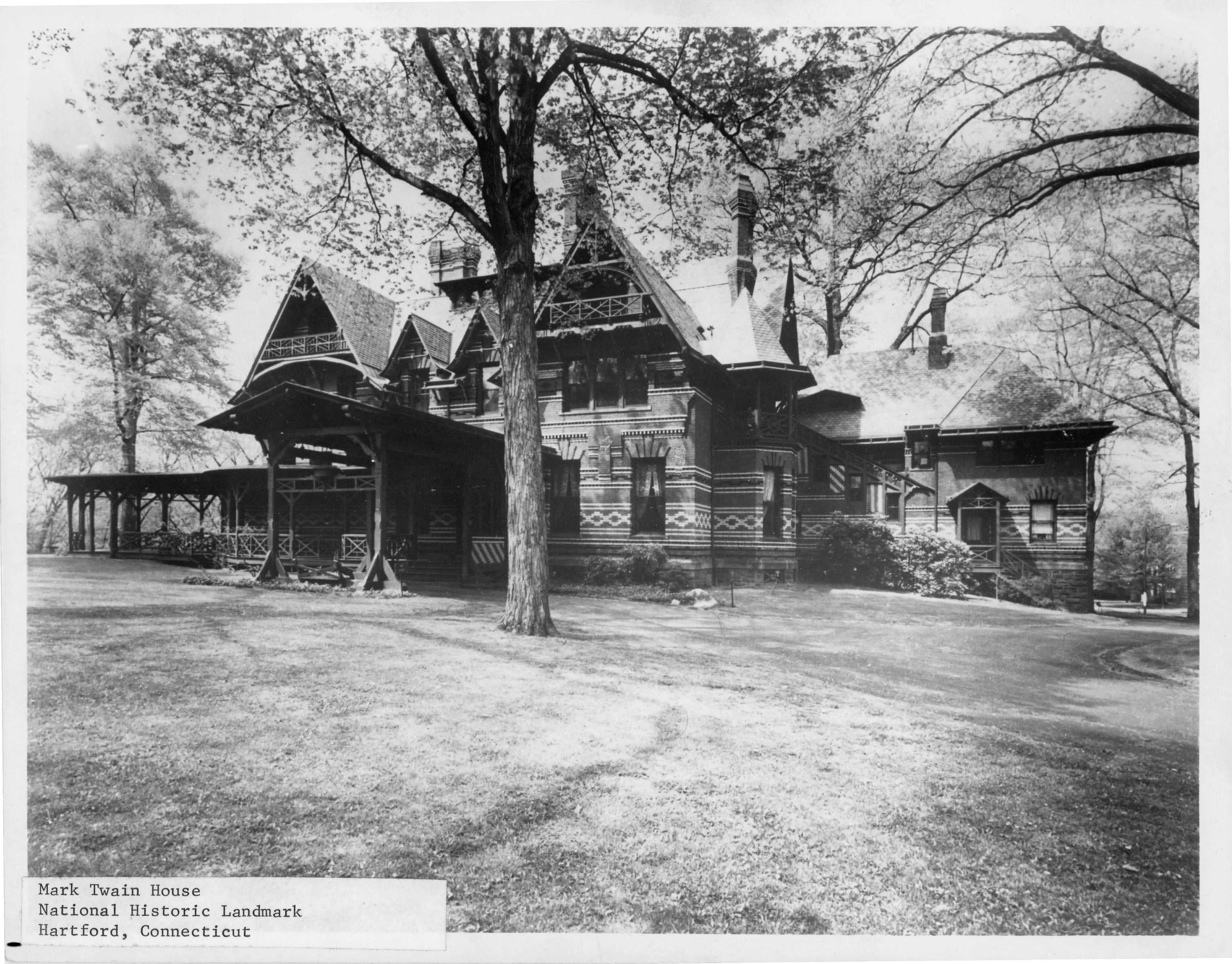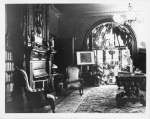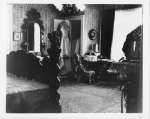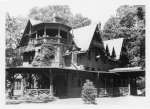Mark Twain House
1874 (photograph ca. 1975)
Add to Favorites:
Add all page(s) of this document to activity:

Add only page 1 to activity:
Add only page 2 to activity:
Add only page 3 to activity:
Add only page 4 to activity:
Add only page 5 to activity:
This was the home of Mark Twain (Samuel Clemens) from 1874, when it was completed, until financial disaster forced Twain to move his family to Europe in 1891. Located in Hartford, Connecticut, it remained his property until 1903 and was designated a National Historic Landmark in 1963. These images and the following descriptions were included with the nomination to add it to the National Register of Historic Places.
In his book Mr. Clemens. and Mark Twain, author Justin Kaplan described the structure as: "The house was permanent polychrome and gingerbread Gothic; it was part steamboat, part medieval stronghold, and part cuckoo clock... It was the conspicuous symbol of his success as a writer, lecturer, and dramatist."
Clemens wanted a radical departure from the typical box-like Hartford houses of the period, and Edward Tuckerman Potter, an architect active in the Hartford area, designed for him this asymmetrical polychromatic brick structure, with sweeping ilrood cornices and gables and flamboyant patterns of black and vermilion brick.
Because of the well-known characters Tom Sawyer and Huckleberry Finn, Clemens is most readily identified with Hannibal and the Midwest. Ironically, however, he did not write in Missouri. It was during the 17 years he lived in this house he commissioned at 351 Farmington Avenue, Hartford, Connecticut, that numerous books, sketches and articles were written including The Adventures of Tom Sawyer, The Adventures of Huckleberry Finn, The Prince and the Pauper, Life on the Mississippi, A Tramp Abroad, and A Connecticut Yankee in King Arthur's Court.
Samuel Clemens first came to Hartford in 1868 to discuss the publishing of Innocents Abroad with Elisha Bliss, president of the American Publishing Company. Clemens liked Hartford from the time of that visit and shortly afterward wrote, "Of all the beautiful towns it has been my fortune to see this is the chief." In 1870 he married Olivia Langdon of Elmira, N.Y., and in 1871 he left his job on the Buffalo, N.Y. Express and moved to Hartford, attracted by its location, industry, and list of literary and social personalities.
Because his publisher, Bliss, and many literary friends lived there, the Clemenses decided in 1873 to make Hartford their permanent residence. With the proceeds from the publication of Innocents Abroad they bought land and commissioned Edward Tuckerman Potter to design their house. The Clemens chose for their home the Nook Farm area, a small, closely knit, influential community where the neighbors, among them Harriet Beecher Stowe and Charles Dudley Warner, and their many guests met for dinner parties and teas, charades, and weekly stag billiard sessions. The elderly Mrs. Stowe often wandered into the Clemenses' home to play their piano. She designed their conservatory with its dripping fountain, similar to ones she designed for other Nook Farm houses.
The house was completed in September 1874 and Mr. and Mrs. Clemens and daughters Susy, born in 1872, and Clara, born in 1874, moved in. The third daughter Jean, was born in 1880. The house represents Samuel L. Clemens, successful author and family man. This house saw his rise to the peak of his creative powers and his tragic financial failure.
In his book Mr. Clemens. and Mark Twain, author Justin Kaplan described the structure as: "The house was permanent polychrome and gingerbread Gothic; it was part steamboat, part medieval stronghold, and part cuckoo clock... It was the conspicuous symbol of his success as a writer, lecturer, and dramatist."
Clemens wanted a radical departure from the typical box-like Hartford houses of the period, and Edward Tuckerman Potter, an architect active in the Hartford area, designed for him this asymmetrical polychromatic brick structure, with sweeping ilrood cornices and gables and flamboyant patterns of black and vermilion brick.
Because of the well-known characters Tom Sawyer and Huckleberry Finn, Clemens is most readily identified with Hannibal and the Midwest. Ironically, however, he did not write in Missouri. It was during the 17 years he lived in this house he commissioned at 351 Farmington Avenue, Hartford, Connecticut, that numerous books, sketches and articles were written including The Adventures of Tom Sawyer, The Adventures of Huckleberry Finn, The Prince and the Pauper, Life on the Mississippi, A Tramp Abroad, and A Connecticut Yankee in King Arthur's Court.
Samuel Clemens first came to Hartford in 1868 to discuss the publishing of Innocents Abroad with Elisha Bliss, president of the American Publishing Company. Clemens liked Hartford from the time of that visit and shortly afterward wrote, "Of all the beautiful towns it has been my fortune to see this is the chief." In 1870 he married Olivia Langdon of Elmira, N.Y., and in 1871 he left his job on the Buffalo, N.Y. Express and moved to Hartford, attracted by its location, industry, and list of literary and social personalities.
Because his publisher, Bliss, and many literary friends lived there, the Clemenses decided in 1873 to make Hartford their permanent residence. With the proceeds from the publication of Innocents Abroad they bought land and commissioned Edward Tuckerman Potter to design their house. The Clemens chose for their home the Nook Farm area, a small, closely knit, influential community where the neighbors, among them Harriet Beecher Stowe and Charles Dudley Warner, and their many guests met for dinner parties and teas, charades, and weekly stag billiard sessions. The elderly Mrs. Stowe often wandered into the Clemenses' home to play their piano. She designed their conservatory with its dripping fountain, similar to ones she designed for other Nook Farm houses.
The house was completed in September 1874 and Mr. and Mrs. Clemens and daughters Susy, born in 1872, and Clara, born in 1874, moved in. The third daughter Jean, was born in 1880. The house represents Samuel L. Clemens, successful author and family man. This house saw his rise to the peak of his creative powers and his tragic financial failure.
This primary source comes from the Records of the National Park Service.
National Archives Identifier: 132353640
Full Citation: Connecticut NHL Twain, Mark, Home; 1874 (photograph ca. 1975); National Register of Historic Places and National Historic Landmarks Program Records: Connecticut; National Register of Historic Places and National Historic Landmarks Program Records, 2013 - 2017; Records of the National Park Service, Record Group 79; National Archives at College Park, College Park, MD. [Online Version, https://www.docsteach.org/documents/document/twain-house, April 25, 2024]Activities that use this document
- American Authors and Historic Preservation
Created by the National Archives Education Team
Rights: Public Domain, Free of Known Copyright Restrictions. Learn more on our privacy and legal page.








